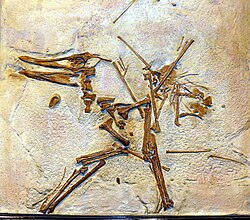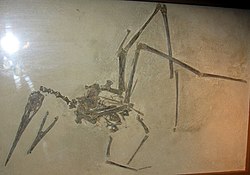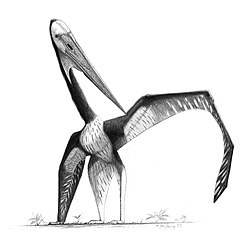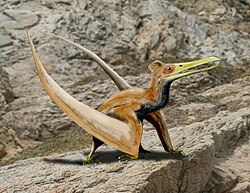
This timeline of pterosaur research is a chronologically ordered list of important fossil discoveries, controversies of interpretation, and taxonomic revisions of pterosaurs, the famed flying reptiles of the Mesozoic era. Although pterosaurs went extinct millions of years before humans evolved, humans have coexisted with pterosaur fossils for millennia. Before the development of paleontology as a formal science, these remains would have been interpreted through a mythological lens. Myths about thunderbirds told by the Native Americans of the modern Western United States may have been influenced by observations of Pteranodon fossils. These thunderbirds were said to have warred with water monsters, which agrees well with the co-occurrence of Pteranodon and the ancient marine reptiles of the seaway over which it flew. [1]
Contents
- Prescientific
- 18th century
- 1780s
- 19th century
- 1800s
- 1810s
- 1820s
- 1830s
- 1840s
- 1850s
- 1850s – 1860s
- 1860s
- 1870s
- 1880s
- 1890s
- 20th century
- 1900s
- 1910s
- 1920s
- 1930s
- 1940s
- 1950s
- 1960s
- 1970s
- 1980s
- 1990s
- 21st century
- 2000s
- 2010s
- 2020s
- See also
- Footnotes
- References
- A-F
- G-L
- M-R
- S-Z
- External links
The formal study of pterosaurs began in the late 18th century when naturalist Cosimo Alessandro Collini of Mannheim, Germany published a description of an unusual animal with long arms, each bearing an elongated finger. He recognized that this long finger could support a membrane like that of a bat wing, but because the unnamed creature was found in deposits that preserve marine life he concluded that these strange arms were used as flippers. [2] The creature was restudied again in the very early 19th century by French anatomist Georges Cuvier, who recognized both that the creature was a reptile and that its "flippers" were wings. He called the creature the Ptero-dactyle, a name since revised to Pterodactylus . [3]
Although Cuvier's interpretation later became the consensus, it was just one of many early interpretations of the creature and its relatives, including that they were bats, strange birds, or the primordial handiwork of Satan himself. [4] Similar animals like the long-tailed Rhamphorhynchus and Gnathosaurus were soon discovered around Europe and it became obvious that earth was once home to a diverse group of flying reptiles. [5] The British anatomist Sir Richard Owen dubbed this vanished order the Pterosauria. Soon after, he described Britain's own first pterosaur, Dimorphodon . [6] Later in the 19th century pterosaurs were discovered in North America as well, the first of which was a spectacular animal named Pteranodon by paleontologist Othniel Charles Marsh. [7]
Various aspects of pterosaur biology invited controversy from the beginning. Samuel Thomas von Soemmering ignited a multi-century debate over how pterosaurs walked on the ground by suggesting they crawled on all fours like bats. August Quenstedt, by contrast, argued that they walked on their hind limbs. [8] In the early 20th century, Hankin and Watson in the first major study of pterosaur flight biomechanics concluded that on the ground these reptiles were altogether helpless and could only scoot along on their stomachs like penguins. [9] The debate gained steam in 1957 when William Stokes reported unusual tracks left by a four-footed animal he suspected was a pterosaur walking along the ground. [10] In 1984, Kevin Padian, who had recently argued that pterosaurs walked on their hind legs, dismissed Stokes's tracks as those of a crocodilian. [11] However, in the mid-1990s, Jean-Michel Mazin and others reported that fossil footprints in Crayssac, France were similar to those reported by Stokes from the US. Mazin's tracks were more obviously pterosaurian in origin and settled the debate in favor of pterosaurs walking on all fours. [10]
Pterosaur paleontology continues to progress into the 21st century. In fact, according to David Hone the early 21st century has seen more progress in pterosaur paleontology than in "the preceding two centuries" combined. He compared this transformative period in pterosaur paleontology to the Dinosaur Renaissance of the 1970s. [12] He also observed that roughly one-third of known pterosaurs were discovered during this brief interval. [13] One of the most notable of these was Darwinopterus , whose body resembled the more primitive long-tailed "rhamphorynchoids", while its skull resembled those of the more advanced short-tailed pterodactyloids. [14] These traits establish the species as an important transitional form, documenting one of the most important phases of pterosaur evolution. [15] Another important new species is Faxinalipterus minima , which might well be the world's oldest pterosaur. [16] The first confirmed pterosaur eggs were also reported from China during the early 21st century. [17]






























































